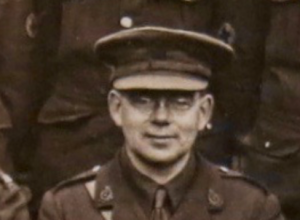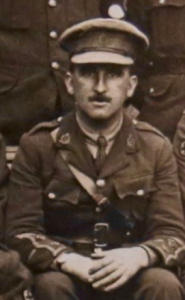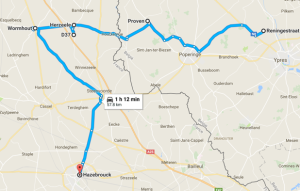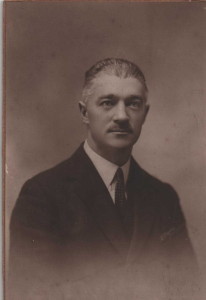Monthly Archives: August 2017
11th August 1917 Saturday
All material produced or reproduced here and throughout this work is the sole copyright of the author and the family of Doctor D.C.M. Page MC.
Percy makes sure of an uncomfortable tour with the Colonel.
“Then on the 11th August the Colonel and I went for a tour of inspection ‘up the line’ via Proven, Poperinghe, Elverdinghe and Brielen. As we were going along the Switch Road a big ‘Perishing Percy’ shell dropped in front of us at the side of the road. Then as soon as we reached the canal bank the Huns started shelling it between Sussex and Fusilier blowing up one dug-out. We walked up Bard’s Causeway towards Pilckem. When we got to the cross-roads a huge ‘coal-box’ shell dropped in amongst a working party of about 200 men of the 29th Division, wounding several of them. Pieces of shell, and clods of earth fell all around us, but we weren’t injured. We helped to rescue the wounded, and then decided to get back to a quieter spot, as the enemy shelling was getting very unhealthy.”
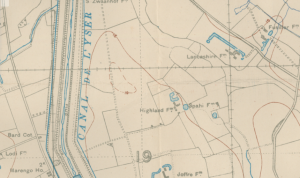
Bard’s Causeway was a bridge close to Bards Cottage (bottom left) Fusilier Farm (top right). Reproduced with the permission of the National Library of Scotland. https://maps.nls.uk/index.html
Find out about our connection with Dr Page and an introduction to his diary here
8th August 1917 Wednesday
All material produced or reproduced here and throughout this work is the sole copyright of the author and the family of Doctor D.C.M. Page MC.
Two Officers Go For a Joyride
“On the 8th August, Capt. Burke and I went for a joy-ride in a motor ambulance to Hazebroucke via Proven, Herzeele, Wormhendt and Steenoorde. At Hazebroucke we bought mess stores, and had a ‘bon’ dinner on the way back at Wormhendt.”
As consistently found throughout the diary a couple of typing errors bely the true names of towns. Even allowing for older versions of town names, some are just wrong, however we do provide educated guesses as to the correct places.
Find out about our connection with Dr Page and an introduction to his diary here
4th August 1917 Saturday
All material produced or reproduced here and throughout this work is the sole copyright of the author and the family of Doctor D.C.M. Page MC.
No prizes for guessing the weather forecast.
“More rain on the 4th August, and very cold. We moved back during the day to a camp in a wood near Chateau Lowrie. I was sent on in advance to take over from the 61st Field Ambulance. There I met Quinn, the Irish Rugby Internationalist, and Jones the Welsh Internationalist. Here we remained at rest until 18th August. Of course we had to carry on our usual work of collecting sick, and attending to them in our hospital – a marquee – but we had any amount of spare time, and most of us spent it in sleeping – at least during the day we did, for at night sleep was impossible owing to the enemy bombing raids, and the attentions of “Perishing Percy” the high velocity gun.”
The Irish rugby player was Joseph Patrick Quinn born November 23rd 1888 who played wing for Ireland up to the outbreak of war in 1914. He scored a try in the 6-0 victory over Scotland at Landsdowne Rd, Dublin in 1914 and also scored a try against France in Paris 1914 as Ireland beat France 8-6. Both Quinn and Jones played in the Five Nations Championship of 1914, with Quinn who played wing scoring tries against Scotland and France. Hardly surprisingly there were two Jones’s playing for Wales but the favourite candidate would be John “Jack” Jones who was part of the “Terrible Eight” a physically hard group that played Ireland (Quinn was not involved) in Belfast. It is regarded as the most violent ever of all rugby internationals. Percy Jones would be the other candidate, but as yet neither of their war records has come to light.
The mention of “Perishing Percy” the high velocity gun is of particular interest. The Germans introduced a high velocity gun in 1918 known as the Paris Gun, but my research so far has failed to unearth one in use in August 1917. This will be updated as and when.
Find out about our connection with Dr Page and an introduction to his diary here
3rd August 1917 Friday
All material produced or reproduced here and throughout this work is the sole copyright of the author and the family of Doctor D.C.M. Page MC.
Rain, rain and more rain
130th (St John) Field Ambulance had borrowed a horse drawn ambulance wagon from the 131st Field Ambulance and while transporting bedding etc., on the way to Mordacq Farm by White Hope Corner a shell hit the wagon. Luckily no one was killed.
“On August 3rd, it rained all day, and was cold and windy. We had lots of sick and wounded to attend to all day. It was pitiful to see the walking wounded coming down the road soaked to the skin, coated with mud, and utterly exhausted. We were happily able to cheer them up a bit with hot cocoa, cigarettes, fresh dressings to their wounds, and a cheery word as we sent them off in the ambulance cars. At White Hope Corner the Huns dropped a shell on to one of our ambulances. It was coming up with dry clothes for the wounded. We managed to salve a good deal of the clothing.”
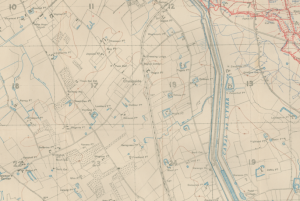
White Hope Corner top left in square 10. Reproduced with the permission of the National Library of Scotland. https://maps.nls.uk/index.html
Find out about our connection with Dr Page and an introduction to his diary here
2nd August 1917 Thursday
All material produced or reproduced here and throughout this work is the sole copyright of the author and the family of Doctor D.C.M. Page MC.
Ceaseless Rain and Sore Feet
“August 2nd was another day of heavy rain. Our attack was completely held up. Our guns were busy all day, and the Germans put a lot of heavy stuff over near us – Mordacq Farm and H.Q. Corner. I helped at Robecq Loading Post all day, and also went down to the ‘Cage’ to attend a few sick and wounded Huns. My feet were painful and swollen owing to being unable to get my boots off for several days.”
The rain continued during what was to be the worst rainfall in Flanders for thirty years. Haig had written the previous day that in a way he was pleased that his troops had not advanced further, the rain had prevented the roads and supply railways from following the advance. This would have meant his guns would be running short of ammunition allowing a counter attack.
Plenty of activity down at Mordacq farm today. The Assistant Director Medical Services ADMS visited and arranged to establish a Field Ambulance there. More tents had been provided and 2 ambulance wagons were assigned there.
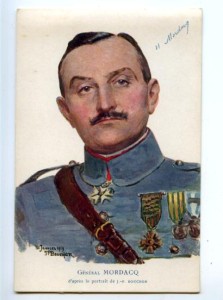
General Mordacq of France, the man who gave his name to the Farm area. By Thirdeyedpyramid – Own work, CC BY-SA 3.0, https://commons.wikimedia.org/w/index.php?curid=19465144
Find out about our connection with Dr Page and an introduction to his diary here
1st August 1917 Wednesday
All material produced or reproduced here and throughout this work is the sole copyright of the author and the family of Doctor D.C.M. Page MC.
The rain interferes with progress
“Next day, August 1st, was very wet, and the wretched wounded were coming down soaked to the skin and covered with mud from head to foot. The attack was held up. As I had only seven wounded Germans to attend to during the day, I was able to help in attending to our own wounded at Mordacq Collecting Post. Our men in the line were having a bad time with the rain and mud, and enemy shelling. The Germans attacked during the afternoon, and gained 100 yards, but we got it back again later. The guards on our left were relieved during the day. The roads were in a terrible state – wagons, guns, motor lorries, and caterpillars were slipping into ditches.”
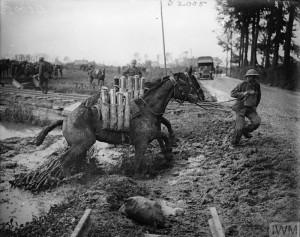
Near Ypres 1st August 1917 carrying shells a horse is dragged out of the mud. To the left a Decauville railway and in the foreground the remains of a standard gauge line.
Copyright: © IWM. Original Source: http://www.iwm.org.uk/collections/item/object/205194794
Mordacq Collecting Post was one of many places named by the British as they mapped the area. Contemporary maps show places with many imaginative names after places at home, but also characters like in this case. Colonel Mordacq was the Commanding Officer of the French 90th Brigade (45th Algerian Division) that were based nearby in 1915. (See the map below). Other places nearby were Joffre Farm. Lancashire Farm, Fusilier Farm, Signal Cottages, Crossing Lodge and Cheapside. Clearly names not easily tripping off the tongues of the local Belgians.
Mordacq Farm is near the bottom of square 17. That is where the Mordacq Loading Post would have been.
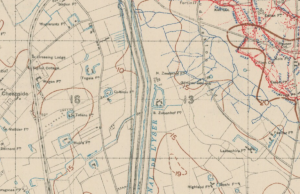
Mordacq’s Camp at the 2nd Battle of Ypres was at Zwaanhof Farm just to the right of centre on the map above. Reproduced with the permission of the National Library of Scotland. https://maps.nls.uk/index.html
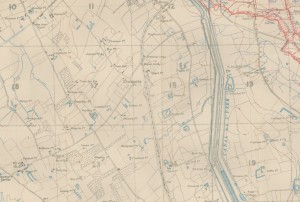
Mordacq Loading Post was at Mordacq Farm located on the map just below the 17 square. Reproduced with the permission of the National Library of Scotland. https://maps.nls.uk/index.html
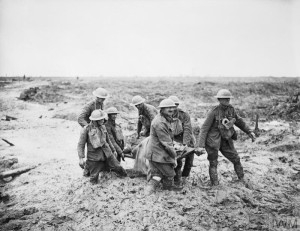
Stretcher bearers at Boesinghe a short way north of Ypres, to the west of the canal on the 1st August 1917. Copyright: © IWM. Original Source: http://www.iwm.org.uk/collections/item/object/205193365
Find out about our connection with Dr Page and an introduction to his diary here
